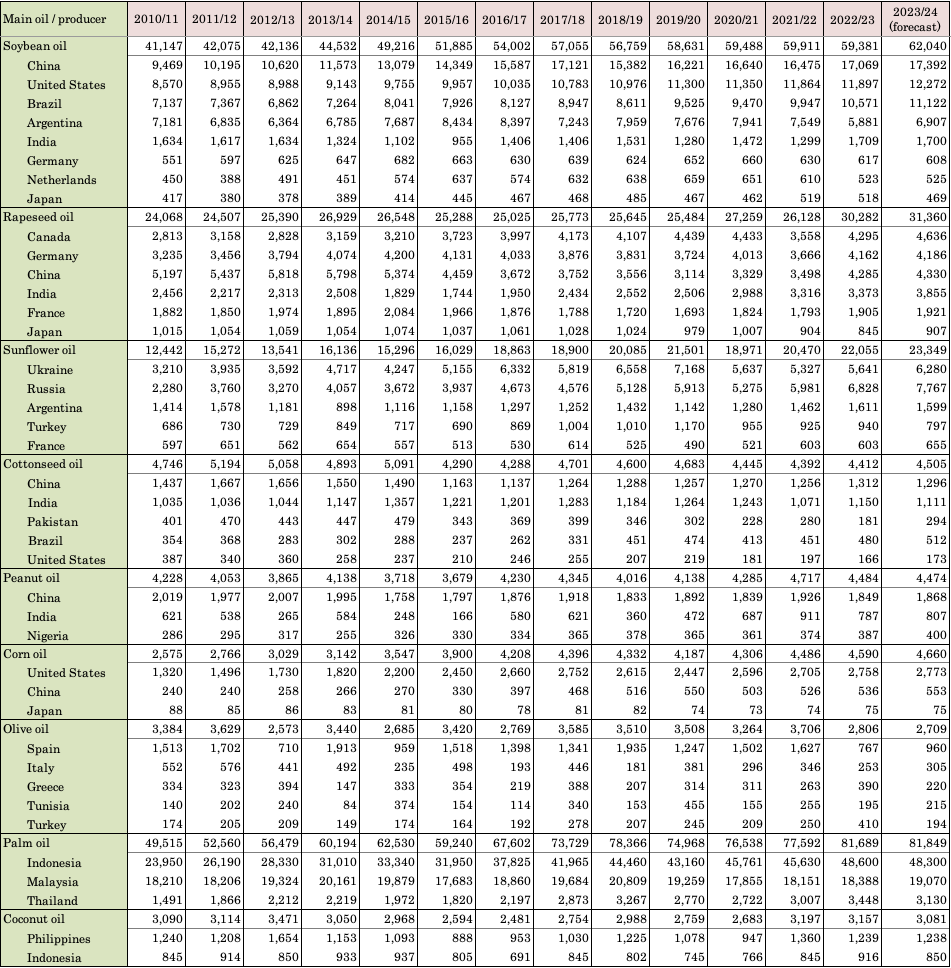Regarding the global production and trading of vegetable oil, statistics have been compiled for 13 types of oil. This includes oil obtained from the aforementioned 10 types of oilseeds, as well as palm oil and olive oil extracted from fruit pulp, and corn oil made from byproducts.
Figure 6: Changes in production amount for main vegetable oil
(Unit: 1,000 tons)

Source: Same as Figure 1
The total production amount of vegetable oil in 2022-2023 was 223.72 million tons. The two types of oil leading the global vegetable oil market are palm oil (81.69 million tons) and soybean oil (59.38 million tons). Rapeseed oil, the top oil produced and consumed in Japan, has the third largest production amount in the world.
Now, let's introduce the production amount for each type of main oil.
1) Soybean oil
The United States is the world's largest producer of soybeans and was also the world's largest producer of soybean oil. However, China has recently started importing and expressing a huge amount of soybeans, and has surpassed the United States. The U.S. and China are followed by Brazil and Argentina. The top five countries account for slightly less than 80% of the total production amount. Argentina has adopted the policy of prioritizing the export of soybean oil over soybeans, so its total production amount of soybean oil sometimes exceeds that of Brazil.
2) Rapeseed oil
Likewise, the main producers of rapeseed are also the top producers of rapeseed oil. Rapeseed oil production in China has increased to 5.1 million tons since 2008-2009. Previously, rapeseed expression plants in China were located in inland areas that are production regions of rapeseed. However, from 2008, plants for the expression of imported rapeseed were constructed in coastal regions of China. The start of expression at these plants caused rapeseed production to increase to 5.8 million tons in 2012-2013. However, the production amount started to decline due to import restrictions that were imposed in response to the decimation of domestic Chinese rapeseed production due to the Blackleg pathogen being carried by rapeseed imported from Canada. Afterwards, based on discussion between China and Canada, restrictions on importing to ports were abolished based on the belief that there was no concern for negative impact on domestically produced rapeseed. This caused an increase in rapeseed production. Since then, in China, rapeseed oil production has been declining due to a decrease in domestic production of rapeseed caused by the conversion to wheat and a decrease in imports of rapeseed caused by the problem of foreign contaminants. In recent years, production amount has been around 3.0 million tons. However, production amount began to increase from 2021 and reached slightly less than 4.30 million tons in 2022-2023 and is expected to increase to more than 4.30 million tons in 2023-2024.
In EU countries, production of rapeseed oil has been increasing in Germany and France due to the growing demand for biodiesel (discussed later).
Canada has become the leading supplier of rapeseed and is currently enhancing domestic rapeseed oil production facilities, leading to a steady increase in the production of rapeseed oil. Due to the poor harvest of rapeseed in 2021, domestic production decreased significantly in 2021-2022. Production trended toward recovery and reached slightly less than 4.30 million tons in 2022/2023, although it did not return to original levels. In 2023-2024, production amount is expected to increase to 4.60 million tons.
In Japan, although production of rapeseed oil had been in an increasing trend due to stable demand for rapeseed oil, production has flattened out in recent years. Due to the poor harvest in 2021 for rapeseed produced in Canada, the production of rapeseed oil in 2021-2022 decreased from normal years. Although it did not return to original levels, production trended toward recovery in 2022-2023 and is expected to increase further in 2023-2024.
3) Palm oil
In 2006-2007, Indonesia surpassed Malaysia to become the world's leading producer of palm oil. Together, Indonesia and Malaysia account for 80% of the global production amount (2022-2023). Palm trees are a tropical perennial (evergreen) tree originating from Africa. Once planted, palm trees maintain high productivity for about 40 years. Moreover, fruit can be harvested continually throughout the year. Therefore, unlike oilseed for which only one crop can be harvested per year, palm trees have an extremely high level of oil productivity relative to the production area. Even rapeseed, which has a relatively high oil content among oilseeds, can only produce less than 800 kg of rapeseed oil per 1 hectare of harvesting area. In contrast, 3.7 tons of palm oil can be produced per 1 hectare of harvesting area. However, productivity decreases once palm trees have exceeded their economic production lifespan (approx. 40 years). It is therefore necessary to replant the palm trees. If high prices continue for palm oil, there will eventually be a replanting that will lead to a temporary suspension of income for producers.
Focusing on the high productivity of palm oil, Africa (the origin of palm oil) is working to increase palm production based on the concept of using palm oil to stimulate industry. Cultivation of palm trees requires a warm and rainy climate. Accordingly, the area between 10º north and south latitude is considered as being appropriate for cultivation. Palm tree cultivation is expanding in Southeast Asian countries such as Thailand, the southern United States, and Central American countries which match these climate conditions.
For these and other types of oils, Table 3 shows recent statistics for the vegetable oil production amount by oil type and country.
Table 3: Changes in production amount for main vegetable oil by country
(Unit: 1,000 tons)

Source: Same as Figure 1




